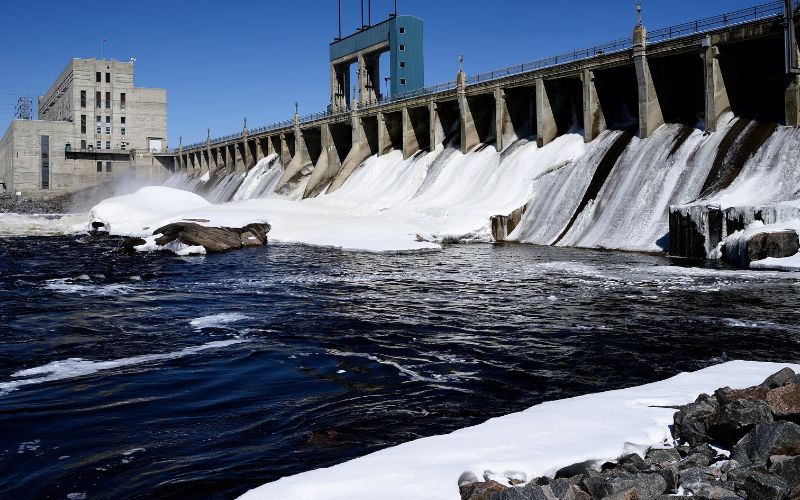
- Details
- By Kaili Berg and Elyse Wild
Federal hydropower dams are harming Native American communities in the Columbia River Basin, according to a first-of-its-kind report by the Department of the Interior released yesterday.
The report fulfills a commitment in National Wildlife Federation v. National Marine Fisheries Service, and examines “the historic, ongoing and cumulative impacts of federal dams on Columbia River Basin Tribes and provides recommendations for how the federal government can uphold its trust responsibilities to the Basin Tribes.” As well, the DOI it is launching a task force to restore native fish in the river basin and expand tribally endorsed clean energy projects in the region.
The Columbia River Basin spans 260,000 miles across seven states in the Pacific Northwest. With more than 470 dams on in its main stem and tributaries, it is one of the most dammed river systems in the world.
The 70-page report examines the adverse effects of 11 federal dams across the basin and the impacts on eight of the basin’s Tribal Nations: Coeur D’Alene Tribe of Indians, The Confederated Tribes and Bands of the Yakama Nation, The Confederated Tribes of the Colville Reservation, the Confederated Tribes of the Umatilla Indian Reservation, the Confederated Tribes of the Warm Springs Reservation of Oregon, the Nez Perce Tribes, Shoshone-Bannock Tribes of the Fort Hall Reservation, and Spokane Tribe of Indians.
Since time immemorial, the Tribes of the Columbia River Basin have served as stewards of its abundant natural resources, focusing on salmon, Pacific lamprey, trout, elk, deer, and other species. The Columbia River and its tributaries are vital to Tribal cultures, supporting cultural practices, spiritual beliefs, and traditional economies deeply rooted in the river’s ecosystems.
However, the construction and operation of federal dams along the Columbia River and lower Snake River dramatically altered these ecosystems. These dams redirected the river’s natural flow, flooded extensive areas of land, and disrupted critical ecosystem functions essential to Tribal life.
According to the report, this transformation, exacerbated by decades of industrial activities and settlement impacts, has disproportionately affected Tribes, undermining their ability to exercise treaty-reserved rights, including the harvest of salmon at traditional sites. These impacts span cultural and sacred sites, traditional lands, fisheries, and economic livelihoods, collectively undermining Tribal sovereignty and well-being. These impacts span cultural and sacred sites, traditional lands, fisheries, and economic livelihoods, collectively undermining Tribal sovereignty and well-being.
The report is the latest in the White House’s efforts to amend environmental harms driven by federal policy in the region. In February, the Biden administration, along with tribal leaders from Washington and Oregon, signed off on a $1 billion plan to restore salmon in the Columbia River Basin.
Help us tell the stories that could save Native languages and food traditions
At a critical moment for Indian Country, Native News Online is embarking on our most ambitious reporting project yet: "Cultivating Culture," a three-year investigation into two forces shaping Native community survival—food sovereignty and language revitalization.
The devastating impact of COVID-19 accelerated the loss of Native elders and with them, irreplaceable cultural knowledge. Yet across tribal communities, innovative leaders are fighting back, reclaiming traditional food systems and breathing new life into Native languages. These aren't just cultural preservation efforts—they're powerful pathways to community health, healing, and resilience.
Our dedicated reporting team will spend three years documenting these stories through on-the-ground reporting in 18 tribal communities, producing over 200 in-depth stories, 18 podcast episodes, and multimedia content that amplifies Indigenous voices. We'll show policymakers, funders, and allies how cultural restoration directly impacts physical and mental wellness while celebrating successful models of sovereignty and self-determination.
This isn't corporate media parachuting into Indian Country for a quick story. This is sustained, relationship-based journalism by Native reporters who understand these communities. It's "Warrior Journalism"—fearless reporting that serves the 5.5 million readers who depend on us for news that mainstream media often ignores.
We need your help right now. While we've secured partial funding, we're still $450,000 short of our three-year budget. Our immediate goal is $25,000 this month to keep this critical work moving forward—funding reporter salaries, travel to remote communities, photography, and the deep reporting these stories deserve.
Every dollar directly supports Indigenous journalists telling Indigenous stories. Whether it's $5 or $50, your contribution ensures these vital narratives of resilience, innovation, and hope don't disappear into silence.
 The stakes couldn't be higher. Native languages are being lost at an alarming rate. Food insecurity plagues many tribal communities. But solutions are emerging, and these stories need to be told.
The stakes couldn't be higher. Native languages are being lost at an alarming rate. Food insecurity plagues many tribal communities. But solutions are emerging, and these stories need to be told.
Support independent Native journalism. Fund the stories that matter.
Levi Rickert (Potawatomi), Editor & Publisher
